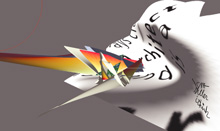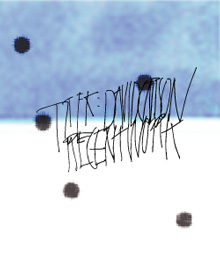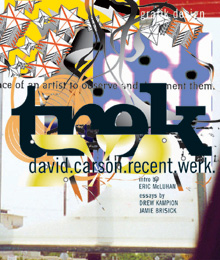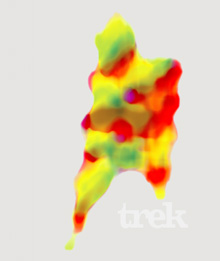 David
Carson is considered by many to be one of the world’s most influential
graphic designers. He describes himself as a “hands-on” designer and has
a unique, intuition-driven way of creating everything from magazines to
TV commercials. In addition to various awards and achievements for his
graphic design and typography work, Carson has also written books on
design, including The End of Print (with Lewis Blackwell), Trek: David
Carson, Recent Werk, and the soon-to-be-released The Rules of Graphic
Design.
David
Carson is considered by many to be one of the world’s most influential
graphic designers. He describes himself as a “hands-on” designer and has
a unique, intuition-driven way of creating everything from magazines to
TV commercials. In addition to various awards and achievements for his
graphic design and typography work, Carson has also written books on
design, including The End of Print (with Lewis Blackwell), Trek: David
Carson, Recent Werk, and the soon-to-be-released The Rules of Graphic
Design.Graphis magazine referred to Carson as a “Master of Typography.” I.D. magazine included Carson in their list of “America’s most innovative designers.” In Newsweek magazine, a feature article said of Carson: “…he changed the public face of graphic design.” Emigre, a graphic design journal that ran for 21 years up until 2005, devoted an entire issue to Carson. His long list of clients includes American Express, AT&T, Atlantic Records, Budweiser, CNN, Levi’s, MTV, Sony, Toyota, Warner Bros., and Xerox, to name just a few.
Carson travels throughout the United States and the world, speaking at seminars and conferences on topics of graphic design and typography. He also enjoys surfing and at one time was a professional surfer.
Layers: David, could you tell us a little about your new book?
Carson: It’s called The Rules of Graphic Design. I’m working on it now in Zurich, Switzerland, where I have a small studio, besides my one in the states. It will show a lot of the new work I’ve done over the past few years, and will, as the title suggests, finally get the official “rules” out on graphic design. It should be out early spring 2008.
My first workshop I ever attended on graphic design was in Switzerland, so the book will no doubt be affected by my being here. I started it in the states and it will be finished there.
Layers: As one of the most well-known and influential graphic designers in the world, how do you balance work and play? Do you still get to surf often?
Carson: I’ve always felt I make my living from my hobby, so I’m lucky in that respect. As Marshall McLuhan said, if you’re totally involved in something, it is no longer work, it’s “play or leisure.”
I surf in the Caribbean every winter. There’s a perfect point break in my front yard. I watch the Internet surf reports, and when a swell is coming, I head down to the British West Indies. It’s a very special place and helps me recharge.
Layers: When creating a design such as a magazine cover, article, or website, what are a few of the most important things a designer should consider?
Carson: Who is the audience, what is that audience’s visual language, what type of things are they seeing? How can you communicate and reinforce visually what is written or spoken, and how can you stand out from the competition in that particular field?
Layers: You redesigned Surfer Magazine in 1991 and founded Ray Gun as well. How does redesigning a medium, whether it’s a magazine or advertising campaign, differ from creating something from scratch?
Carson: In some ways they are very similar. You have to determine who the audience is, and what is the message you want to portray through the design. A new design gives you a bit more freedom, as you can help define the language. I think Ray Gun helped establish a certain visual language for alternative music. But redesigning, or inventing something new, both have their challenges and rewards, and I enjoy both. As long as you look for the solution in the particular thing you are working on, and not some predetermined formula or system, you will never run out of ideas.
Layers: I remember attending a seminar when you spoke at a local school here in Central Florida years ago, and you told us a story about where you had the text in a magazine article covered up or unreadable, but the layout was spectacular. Do you have any other humorous or quirky stories of editors getting mad that your layout caused the article to be unreadable?
Carson: You might be referring to the article I set in the font Dingbat, largely because I found the article very boring. To start designing, I have to read the article, or brief it or listen to the music, to see where it takes me visually and emotionally. It was [a] bit funny, maybe, that at Ray Gun some of the writers complained early that their articles were hard to read. But then by the 30th issue, the same writers would complain if they thought their articles were too easy to read! The layout came to signal something worthwhile to read, so the writers came to look forward to see how their words were interpreted.
Layers: Some have said that you are heavily influenced by the ocean. Is that true, and where do you find other sources of inspiration when creating a design?
Carson: My environment always influences me. I’m always taking photos and I believe things I see and experience influence the work. Not directly, but indirectly in some shape or color or something that registers. The ocean has always played a big part in my life, but it’s hard to say exactly what that influence is in regards to the work. But I’m always scanning the environment I’m in, and I’m sure it ends up in the work.
I think it’s really important that designers put themselves into the work. No one else has your background, upbringing, life experiences, and if you can put a bit of that into your work, two things will happen: you’ll enjoy the work more, and you’ll do your best work. Otherwise, we don’t really need designers—anyone can buy the same programs and learn to do “reasonable, safe” design.
Layers: You have branched out into directing television and video commercials. What aspects of print design do you also use when directing video? Do you often focus on typography as a major part of it?
Carson: I’m often asked to direct commercials where the type plays an important role, and sometimes I add type to other peoples’ work. My approach is very similar to print: who is the audience, what is the emotion of the spot, or the feeling we want the viewer to get from watching, and how visually can we make that happen?
Layers: Could you give an example of a video project that you enjoyed directing? What software do you or your associates use when creating these, and do they include Adobe After Effects?
Carson: After Effects is hugely important in the commercials I work on. It’s hard to imagine how we did them before. Well, actually I know—we did them in very expensive suites in post-editing houses in Los Angeles and New York! I just did some work for Saturn cars, and it was almost all done with After Effects. It’s clearly the best tool for motion graphics.
I directed an in-flight commercial for American Airlines—a 90-second spot—that I enjoyed very much, from casting the actors to selecting footage to having some fun with the type. I also made a commercial for the band Nine Inch Nails for the MTV music awards, and the launching of Lucent Technologies, which were type-only spots. In general, I’m drawn more toward moving images and type, but I’ll always do print, even though “print has ended.”
Layers: Finally, what advice would you have for other graphic designers just starting out?
Carson: Do what you love, trust your gut, your instincts, and intuition. And remember the definition of a good job: If you could afford to, if money wasn’t an issue, would you do the same work? If you would, you’ve got a great job! If you wouldn’t, what’s the point? You’re going to be dead a long time. So find that thing, whatever it is, that you love doing, and enjoy going to work for, and not watch the clock or wait for weekends and holidays.
Link to Article
SPEAK UP
David Carson
November 12, 2003
by Armin Vit
by Armin Vit
Speak Up: The first question
that comes to mind is an easy one (at least for me), It has been quite some time
since we’ve heard anything from “Camp David,” where have you been
for the past five years? Has it been a conscious decision to stay off the public
eye?
David Carson: Family, traveling,
teaching, making books, designing, having fun. I’m probably an ‘overheated
medium’. You can read about that in
Understanding Media. Once you stop doing a monthly magazine you tend to disappear
a bit from the media end of things. Just all part of the natural cycle. Which
of course is fine. I never expected this thing to get as big as it did, or last
so long, just by doing something I love.
It’s been a crazy 5 years, well actually a crazy decade or so, but no complaints. I think I’m one of the most fortunate designers in the world to get to do what I do. I’ll resist giving you a laundry list (well, semi-resist) of clients over the past few years, but one I’m most excited about is Jim Richardson, over at Union Fonts. I was honored to be asked to design a poster that will help raise money to build 2 orphanages for kids living with AIDS in Africa. That, along with other pro-bono work for children’s art museums in Germany and South Carolina has been some of the most rewarding work. Also being art director and designer for the Marshall McLuhan estate has been a great experience. We’ve got projects lined up well into the next 5 years, working closely with his son Eric and wife Corrine.
It’s been a crazy 5 years, well actually a crazy decade or so, but no complaints. I think I’m one of the most fortunate designers in the world to get to do what I do. I’ll resist giving you a laundry list (well, semi-resist) of clients over the past few years, but one I’m most excited about is Jim Richardson, over at Union Fonts. I was honored to be asked to design a poster that will help raise money to build 2 orphanages for kids living with AIDS in Africa. That, along with other pro-bono work for children’s art museums in Germany and South Carolina has been some of the most rewarding work. Also being art director and designer for the Marshall McLuhan estate has been a great experience. We’ve got projects lined up well into the next 5 years, working closely with his son Eric and wife Corrine.
SU: It has been more
than ten years after you not only challenged but actually changed many
of the notions that ruled graphic design for decades and decades, is it
hard (or make your work seem futile) that graphic design today is
strongly minimal and rigid once again?
DC: It’s all cyclical,
everything and anything. Graphic design has been loosening up and
getting more expressive and experimental again, especially at the
student level.
 |
I never expected this thing to get as big as it did, or last
so long, just by doing something I love.
|
SU: Related to the question
above, at the height of your influence (early to mid 90s) the “deconstructivist”
(to label it somehow) was one of the most apparent trends in graphic design, do
you see any of it still lingering today?
DC: I’ve really never associated
myself with any particular ‘movement,’ and labels in general can be
a bit futile/silly. I never get invited to any of the deconstructionist club meetings,
luncheons, or actually ANY of their social events now that I think about it.
SU: It would be
unrealistic to disregard the effect you had on our profession as nothing
but a passing fad, you undoubtedly changed the way graphic design is
practiced and viewed; after years and years of praise, disdain, insults
and honors your contributions to the field have been well documented and
cemented as one of the most important, what is your reaction to that?
DC: Well, thank you. It’s
hard to digest it all with any objectivity.
I never get invited to any of the
deconstructionist club meetings, luncheons, or actually ANY of their
social events now that I think about it.
|
 |
SU: In a broad sense, has your
design aesthetic changed at all in recent years? Are your clients still expecting
“Ray Gun David Carson” when they hire you?
DC: The basic approach
remains similar: personal, intuitive and extremely self-indulgent.
Hopefully it’s continuing to evolve. But Ray Gun was almost a decade ago
and I rarely hear it referenced, especially from clients. They do come
to me, like I’m sure they do with other designers, because they feel
they want something a bit different, or less predictable, or maybe just
by accident because they find me in the phone book. And lots of people
hate what I do and stay far away.
SU: Many of our profession’s
greats (Bass, Rand, Tibor) are recognized for their work, but also for their personalities
(good or bad). Any designer over forty years has a great story (heart-warming
is a common theme) to tell about any of these iconic designers. Obviously separating
the work from the person is almost impossible. In my opinion you belong among
these elite of designers, but your reputation seems to be, let’s say…“not
good.” Does it worry you that any tale about you from a designer in their
late twenties, early thirties starts or ends (in some cases both) with “what
an asshole”?
DC: Well, you’ve grouped
me with some majorly talented people I’m not sure I belong with, but thank
you. I think the name-calling thing just comes with the territory. It’s just
part of the whole experience. And I wouldn’t trade any of it.
I served on the board of directors with Saul Bass for the Aspen Design Conference and he used to talk to me a lot about what he went through getting started, becoming famous, etc. He had a lot of good advice I’ve tried to heed over the years. He went through a surprising amount of the same stuff I have. I spent some interesting late nights in Tibor’s tiny little hotel room in Venice, Italy, learning (actually NOT learning) how to drink Grappa, and he of course had been through the name-calling and whole bad-boy-label thing and had a ton of great insight. One thing we all agreed on was the people who seem to say the meanest/least truthful things are generally the ones who don’t know you or have never actually met you and/or spent any real time with you.
I don’t think you’d find even one of the hundreds of my workshops attendees who would agree with that [being an asshole] opinion… And very few of the thousands of people worldwide who have heard me lecture would agree with that. I don’t doubt they’re out there -I just don’t hear from them. I’ve always been shy, and it takes me a while to feel comfortable with new people. I think sometimes that shyness gets misinterpreted. And then, other times, I’ve probably just been a real asshole.
But I have no worries AT ALL about the good stories emerging. From times spent looking at individual students work around the world, to helping bring together designers in war torn Serbia, Belgrade, Kosovoe, Bosnia, Slovenia, Tel Aviv, etc. Now I have offers to go to Iran, Afganistan, Pakistan, India, Korea and China and speak with their designers. I had an amazing first experience in Moscow last summer. It’s always the people you remember the most from these journeys, not the physical place. One of my best workshops ever was in Caracas, Venzeuala just last month, with other especially meaningful ones in Ecuador, Mendoza, Argentina, Santiago. Maribor and Villa Julia outside Baltimore. I rarely get paid anything for the talks and/or workshops, but they are well worth the life experience. Nothing yet from Iraq. I get hundreds of emails from around the world daily, many from the demographic you mention. Some typical ones I’ve included in TREK.
I served on the board of directors with Saul Bass for the Aspen Design Conference and he used to talk to me a lot about what he went through getting started, becoming famous, etc. He had a lot of good advice I’ve tried to heed over the years. He went through a surprising amount of the same stuff I have. I spent some interesting late nights in Tibor’s tiny little hotel room in Venice, Italy, learning (actually NOT learning) how to drink Grappa, and he of course had been through the name-calling and whole bad-boy-label thing and had a ton of great insight. One thing we all agreed on was the people who seem to say the meanest/least truthful things are generally the ones who don’t know you or have never actually met you and/or spent any real time with you.
I don’t think you’d find even one of the hundreds of my workshops attendees who would agree with that [being an asshole] opinion… And very few of the thousands of people worldwide who have heard me lecture would agree with that. I don’t doubt they’re out there -I just don’t hear from them. I’ve always been shy, and it takes me a while to feel comfortable with new people. I think sometimes that shyness gets misinterpreted. And then, other times, I’ve probably just been a real asshole.
But I have no worries AT ALL about the good stories emerging. From times spent looking at individual students work around the world, to helping bring together designers in war torn Serbia, Belgrade, Kosovoe, Bosnia, Slovenia, Tel Aviv, etc. Now I have offers to go to Iran, Afganistan, Pakistan, India, Korea and China and speak with their designers. I had an amazing first experience in Moscow last summer. It’s always the people you remember the most from these journeys, not the physical place. One of my best workshops ever was in Caracas, Venzeuala just last month, with other especially meaningful ones in Ecuador, Mendoza, Argentina, Santiago. Maribor and Villa Julia outside Baltimore. I rarely get paid anything for the talks and/or workshops, but they are well worth the life experience. Nothing yet from Iraq. I get hundreds of emails from around the world daily, many from the demographic you mention. Some typical ones I’ve included in TREK.
 |
TREK is my latest self-indulgent tome – my first design
book in over 5 years.
|
SU: Can you tell us about TREK?
DC: TREK is my latest self-indulgent
tome – my first design book in over 5 years. It’s my fourth book.
I see these books more like record albums, (actually, CDs I guess). They’re put together at different periods in one’s life, and thus the contents are partly dictated by life events. I think this same concept holds true for many musicians. TREK touches briefly on a lot of subjects, including 9/11, the Iraq war, family, friends, love, loss, relationships, the Probes of Marshall McLuhan, student work, and includes one of the best ads I’ve ever seen Ð so good I made it the back cover. A classic example of how design and advertising can work together to actually do something that matters.
And, yes, there’s a healthy dose of good ol’ show + tell – sometimes without the tell.
As always, I see things after printing that I wish I had done differently, and that’s certainly the case with TREK. But I find these books fun to do, and the strange thing is you never actually ‘finish’ designing - it just gets printed at some point during the process…
Inside the book there’s also a few surprises, and 3 excellent essays, with an especially thought-provoking introduction by Eric McLuhan, and one by Drew Kampion, one of my favorite writers. I think the people who like or follow my work will find TREK interesting, and those who don’t will have plenty of new material.
Plus it’s really heavy.
I see these books more like record albums, (actually, CDs I guess). They’re put together at different periods in one’s life, and thus the contents are partly dictated by life events. I think this same concept holds true for many musicians. TREK touches briefly on a lot of subjects, including 9/11, the Iraq war, family, friends, love, loss, relationships, the Probes of Marshall McLuhan, student work, and includes one of the best ads I’ve ever seen Ð so good I made it the back cover. A classic example of how design and advertising can work together to actually do something that matters.
And, yes, there’s a healthy dose of good ol’ show + tell – sometimes without the tell.
As always, I see things after printing that I wish I had done differently, and that’s certainly the case with TREK. But I find these books fun to do, and the strange thing is you never actually ‘finish’ designing - it just gets printed at some point during the process…
Inside the book there’s also a few surprises, and 3 excellent essays, with an especially thought-provoking introduction by Eric McLuhan, and one by Drew Kampion, one of my favorite writers. I think the people who like or follow my work will find TREK interesting, and those who don’t will have plenty of new material.
Plus it’s really heavy.
SU: Sticking with the personality
questions – you are no longer the “bad boy” of graphic design and
the hoopla surrounding you is not as strong anymore, what do you think defines
you today?
DC: Dad.
 |
And, yes, there’s a healthy dose of good ol’ show + tell –
sometimes without the tell.
|
SU: Given that the
profession is supposedly in a slump, what do you see in graphic design
today? Is there anything out there that gets your attention?
DC: I like to see what’s happening in street art, and how that is changing or affecting advertising art.
SU: Looking back, as well as forward, on your career, what do you think is your major contribution to the field?
DC: I opened a few doors, and inspired some folks.
SU: Thanks David.
This interview has been conducted exclusively for Speak Up.
Reproduction without our written consent is strictly prohibited. Please contact us if you would like to use it for educational purposes or if you are interested in other means of reproduction. Thank you for your understanding.
Link to ArticleReproduction without our written consent is strictly prohibited. Please contact us if you would like to use it for educational purposes or if you are interested in other means of reproduction. Thank you for your understanding.
No comments:
Post a Comment